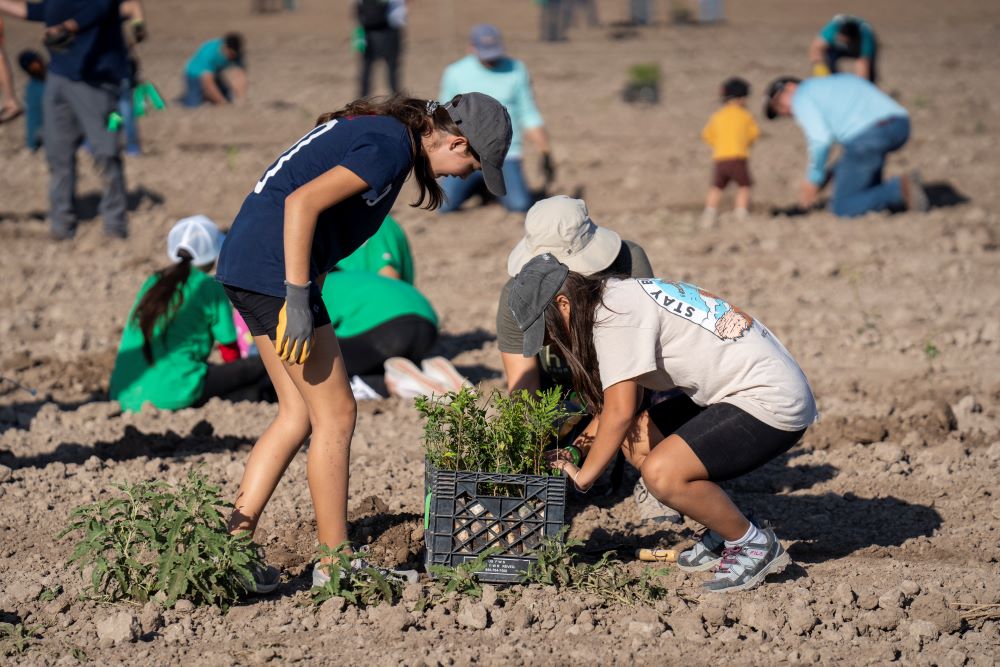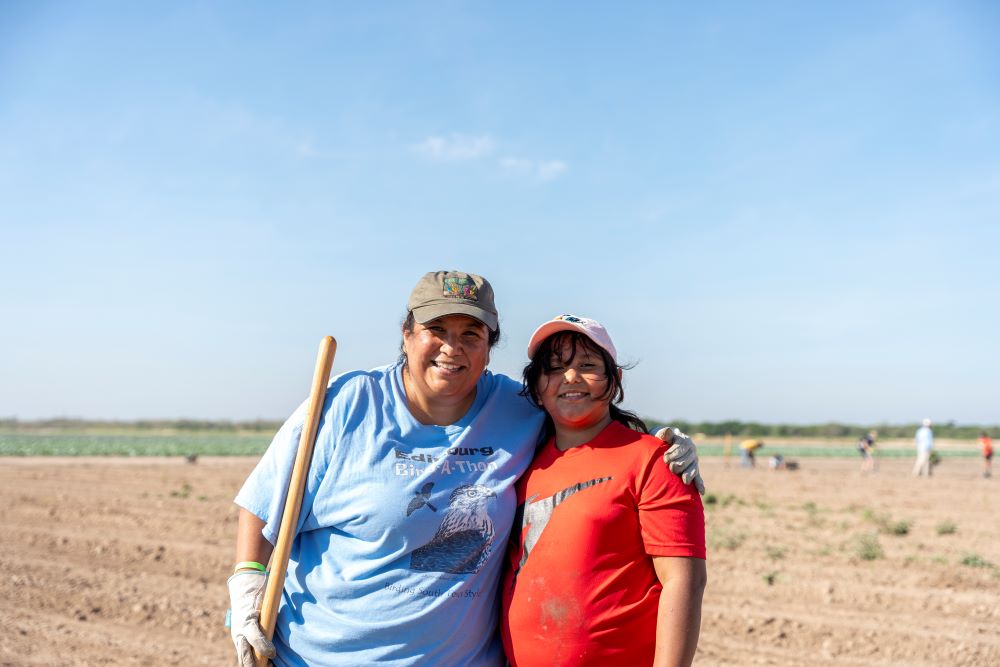IT’S MORNING in the Texas Rio Grande Valley. Large pickup trucks wind through wisps of fog that cling to the ground and scatter the rising sun, illuminating an empty field in gold. Furrows of freshly tilled soil extend rich and brown across 12 acres of former agricultural land. By the end of the day, this ground will hold a nascent forest.

Photo Credit: Jeremy Inglesi Jr. / American Forests
The 29th annual Rio Reforestation, a community planting event, has drawn more than 700 volunteers to this location. In the next four hours, they will plant 12,000 seedlings representing 32 different species. The effort is sorely needed. Less than 10% of the subtropical thornforests that once blanketed the Rio Grande Valley remain. Swaths of these woodlands were cleared decades ago for agriculture, and creeping urbanization, climate change and changes to the hydrology of the Rio Grande River continue to slowly eat away at this ecosystem, stressing the remaining forest.
“Thornforests serve both community and ecosystem resilience,” says Jon Dale, director of Texas and Mexico with American Forests. “We have over 500 bird species and 1,200 plant species here in the region. At the end of the day, so much of that biodiversity is dependent on just this ecosystem.”
Cars and buses begin to arrive as staff with the U.S. Fish and Wildlife Service, American Forests and other partners finish setting up. School children tumble out, along with small families, community volunteer groups, college students from the University of Texas Rio Grande Valley and local Girl Scout troops. They claim shovels and watch a demonstration on how to plant before walking far into the field where rows of colorful crates hold seedlings waiting to be planted. Holes are dug, the seedlings are lifted and placed, and gloved hands gently fill in the soil.

Photo Credit: Jeremy Inglesi Jr. / American Forests
Adjacent to the site, a mature Tamaulipan thornforest sways in the distance. Seven years ago, the land looked much like its neighboring bare counterpart. But since the site was planted during the 2016 Rio Reforestation, orderly rows have grown into a chaotic thicket of species like Texas ebony, tenaza, Wright’s acacia and snake eyes. Deer have moved onto the land, birds are nesting and butterflies tease nectar from flowering shrubs. It’s the perfect habitat. The perfect thornforest.
BUILDING ECOSYSTEM AND COMMUNITY RESILIENCE
This year is a particularly remarkable one for Rio Reforestation. The event was put on hold for three years following the COVID-19 pandemic. And while smaller planting projects occurred in the surrounding area, none had the large regional draw and impact of Rio Reforestation, which the Fish and Wildlife Service and American Forests began planning once more in early 2023.
According to Dale, there was an urgency to bring back the event, which gives attendees the opportunity to interact with, support and learn about the native thornforests. Thornforests provide critical social, economic and environmental benefits to the region, such as mitigating flooding and supporting an abundance of wildlife that drive ecotourism from all over the world. Yet few locals have the opportunity to engage with it in their everyday lives because such little of this native ecosystem remains.
“It’s so often in this community here that people don’t have an active piece of the conservation of this habitat,” Dale says. “By coming together as citizens and doing this community event, we’re actually giving some of that back.”

Photo Credit: Jeremy Inglesi Jr. / American Forests
As community members come together to dig and plant, they learn about the importance of thornforests, an experience the organizers hope will help establish connections with the ecosystem and inspire advocacy.
“Rio Reforestation has a really special meaning,” says Romeo Garcia, manager of the Santa Ana National Wildlife Refuge with the Fish and Wildlife Service. “There are people who are bringing their grandkids who had the opportunity to plant trees during past community planting events back in the early ‘80s. That means a lot. That means we’re putting memories in people in the community, and they’ll have the curiosity to come back and continue helping us on conservation efforts.”
For volunteer Marisa Oliva, it’s a chance to pass the lesson of conservation on to her daughter Julia.
“I wanted to bring my daughter for the first time to do what we could to help wildlife and restore habitat,” she says. “We do a little bit of this in our own yard, too, because we like bringing wildlife back to our area.”
Gisel Garza, who is currently a project manager for the Lower Rio Grande Valley with American Forests says Rio Reforestation helped guide her career path years ago when she attended the event as a biology major.

Photo Credit: Jeremy Inglesi Jr. / American Forests

Photo Credit: Courtesy of Gisel Garcia
“In college, I knew I liked plants, and I wanted to be a scientist,” she says. “Seeing professionals out there with the Fish and Wildlife Service made me think this was something I wanted to do. Participating this year in my current role meant a lot. It makes me happy to see young kids exposed to Rio Reforestation at an even earlier age. I wish I had been.”
THINKING BIG IN TEXAS
Rio Reforestation is one of American Forests’ largest community plantings, but the organization, which has partnered with the Fish and Wildlife Service on thornforest restoration since 1997, is on the precipice of its greatest impact in the region.
During the event, the partners announced American Forests has been awarded a $10 million contract from the Fish and Wildlife Service to lead conservation in the Valley over the next four years. In addition to reforesting 800 acres — more than 66 times what was achieved during Rio Reforestation — American Forests will also advance thornforest research and create opportunities for locals to access and learn about thornforests in schools and newly developed community forests.
The work, and Rio Reforestation, are part of a greater tidal wave of recent activity that seeks to rewrite the future for thornforests in the Rio Grande Valley through science-based conservation and community involvement. In 2018, a coalition of state and federal agencies, universities, nonprofits and community organizations came together to form the Thornforest Conservation Partnership, which collaborated with American Forests to produce the Thornforest Conservation Plan, a blueprint for ecosystem conservation that is serving as the foundation for activity under the historic new award.
“I feel really proud that we’ve been a catalyst for that coming together, that partnership,” says Jad Daley, president and CEO of American Forests. “Yes, it’s been about getting trees in the ground, but it’s been just as much about building that community collaboration so we can keep doing this again and again. We can get this done at a scale that can bring this whole Valley back to life with thornforests.”
While Rio Reforestation may continue to evolve in shape and scope, one thing is for sure — the event will serve as an annual moment to pause and take in all of the progress for a community that continues to fight to preserve its thornforests.
Liane O’Neill writes from Portland, Ore., and serves as American Forests’ senior brand manager for Resilient Forests.